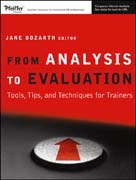
From analysis to evaluation: tools, tips, and techniques for trainers
Bozarth, Jane
Jane Bozarth, author of e-Learning On a Shoestring, offers a wealth of tools from leading training practitioners that anyone can use designing or delivering training. This comprehensive resource contains all the tools of the trade: worksheets for assessing training needs and writing goals and objectives; checklists for organizing the venue; tools for analysis and structuring content; and instant evaluation and measurement surveys, which can be customized from theaccompanying CD. The book also offers advice for trainers including how to make effective use of props, staying energized, marketing training programs, andother things they don't tell you in train-the-trainer courses. INDICE: Acknowledgments. Preface. Introduction. Tool 1. ADDIE Wheel. CHAPTER 1. ANALYZE. Data Collection. Tool 2. Data Gathering Strategies. Whats the Problem? Tool 3. Grid: Is It a Training Problem? Tool 4. Training Assistance Request Worksheet. Tool 5. Twenty Questions You Should Always Ask Before Starting Any Training Program Tool 6. Needs Analysis for Training Courses. Tip. Saying ‘No’. Analysis: Job, Task, and Skills. Tool 7. Job/Content Analysis. Tool 8.Task Analysis Form. Tool 9. Skills Chart. Analysis: Learners. Tool 10. Learner Characteristics. Tool 11. Learner Technology Skills. Tool 12. Existing Training: Who Gets What? Synthesizing and Reporting Data. Tool 13. Needs Analysis Recap. Tool 14. Analysis Report Template. Chapter 1 Wrap-Up. Analysis: The REALStory vs. the Sacred Story. Tips for Achieving Management Commitment to Training Solutions. Tool 15. Worlds Quickest Training Needs Analysis. Additional Suggested Resources. CHAPTER 2. DESIGN. Tool 16. Find Your 20 Percent. Developing Objectives. Tips for Creating Objectives: Rules of Thumb and Common Errors. Tool 17. Types of Objectives: Seven Levels. Tool 18. Writing Objectives: Worksheet. Testing. Tip. Why Test? Tool 19. Tie Test Items to Objectives. Tool 20. Checklist for Culturally Unbiased Test Item Construction. Choosing a Delivery Format. Tool 21. Delivery Selection Flowchart. Tool 22. Delivery: Traditional or ‘E’? Or Both? Course Design and Lesson Planning. Tool 23. Course Design Worksheet. Creating Lesson Plans. Tool 24. Lesson Plan Development Checklist and Content Matrix. Tool 25. Lesson Plan Template A: Overview Format. Tool 26. Lesson Plan Template B: Outline Format. Storyboarding Tools. Tip. Storyboarding e-Learning with PowerPoint. Tool 27. Storyboard Template A: PowerPoint Format. Tool 28. Storyboard Template B: Word Format. Cost and Time Estimators. Tool 29. ‘Rule of Thumb’ Costs for Training. Tool 30. Training Design Time Estimate Worksheet. Tool 31. e-Learning Design Time Estimator. Project Planning. Tool 32. Training Project Risk Assessment: ‘Quick and Dirty Risk’. Tool 33. e-Learning Project Plan Outline. Tool 34. Classroom Training Project Planning Outline. Tool 35. Project Planning Worksheet. Chapter 2 Wrap-Up. Tool 36. Finks Principles of Good Course Design. Tips for Working with Subject-Matter Experts. Additional Suggested Resources. CHAPTER 3. DEVELOP. Instructional Methods: Basics. Tool 37. Instructional Methods: Advantages and Disadvantages. Tool 38. Choosing a Lecture. Tool 39. Choosing a Demonstration. Tool 40. Choosing a Discussion. Instructional Methods: Advanced Techniques. Tool 41. Using a Case Study. Tool 42. Using a Role Play. Tool 43. Getting the Most from the Stories You Use. Tool 44. The Job Aid Job Aid. Matching Methods to Learning Styles and Preferences. Tool 45. Activities for Visual, Auditory, and Kinesthetic Preferences. Tool 46. Multiple Intelligences Activities. Tool 47. Multiple Intelligences Matrix. Tool 48. e-Learning Development Techniques: Mix It Up!. Developing Materials. Tips for Great Handouts. Tool 49. Evaluation Worksheet for Graphic Treatment. Developing Instructor Guides. Tool 50. How to Write an Instructor Guide. Tool 51. Sample Scripted Instructor Guide. Tool 52. Sample Outline Instructor Guide. Tool 53. Sample Overview Instructor Guide. Tool 54. Instructor Guide Template Using Icons. Tool 55. Instructor Guide Template: Synchronous Training. Tool 56. Instructor Guide Template: Teleconference. Tool 57. Instructor Guide Template for a Video Conference Featuring a Guest Speaker. Tools and Tips for Online Training. Tips for What Learners Want: Developing Successful Online Learning Programs. Tips for Creating Self-Paced Online Courses. Tool 58. Online Course Syllabus Template. Tool 59. Principles of Online Design Checklist. Chapter3 Wrap-Up. Tool 60. Training Design Checklist: Quick Version. Tool 61. Training Design Checklist: Comprehensive Version. Additional Suggested Resources. CHAPTER 4. IMPLEMENT. Critical Trainer Skills. Five Areas of Preparation. Tips for Giving Instructions. Incredible Credibility. The Seven Principles of Facilitation. Tool 62. Mapping Discussion Flow. Tips for Using Props in Training. Tips for Marketing Your Training Programs. Tips for Working with Multicultural Audiences. Tool 63. Trainer Skills Assessment. Dealing with Challenges. Tips. Delivering an Unpopular Message. When Difficult Issues Threaten Training. Tips for Handling Challenging Learner Behaviors. Trainer Self-Preservation and Self-Development. Tool 64. Training Logistics Action Items. Tool 65. Training Program/Activity Worksheet. Tool 66. Speaker/Session Information Worksheet. Tool 67. Trainers Planner for Offsite Training. Trainer Self-Preservation: Taking Charge of Your Recharging. Tool 68. Best Books for Trainers. Tips for the Lone Ranger Trainer. Things They Dont Tell You in Train-the-Trainer Courses. Additional Suggested Resources. CHAPTER 5. EVALUATE. Formative Evaluation. Tool 69. Formative Self-Evaluation Tool. Tool 70. Course Daily Reflection. Tips for Formative Evaluation. Summative Evaluation: Client, Team, and Trainer Evaluation of Training. Tool 71. Post-Mortem: Clients Evaluation of Training Project. Tool72. Post-Mortem: Teams Evaluation of Training Project. Tool 73. Trainers Evaluation of Session/Learners. Summative Evaluation: Learner Evaluation of Training. Tool 74. Learner Course Evaluation Template A: Overview. Tool 75. Learner Course Evaluation Template B: Narrative. Tool 76. Learner Course Evaluation Template C: Detailed. Course and Program Evaluation. Tool 77. Strategies for Evaluating Training Results. The Kirkpatrick Taxonomy for Evaluating Training Programs. What Is ‘ROI’? Tool 78. Evaluating Training at Five Levels. Alternatives to Kirkpatrick? Tool 79. Stufflebeams CIPP Model of Program Evaluation. Additional Suggested Resources. extra space here. Contributors. About the Editor. How to Use the CD-ROM.
- ISBN: 978-0-7879-8201-0
- Editorial: Jossey Bass
- Encuadernacion: Rústica
- Páginas: 320
- Fecha Publicación: 23/04/2008
- Nº Volúmenes: 1
- Idioma: Inglés
